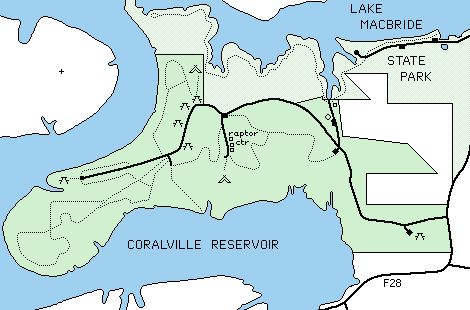
Macbride Nature Recreation Area (formerly the Macbride Field Campus of the University of Iowa) comprises approximately 480 acres located on a forested peninsula in the Coralville Reservoir, adjacent to Lake Macbride State Park.

To reach this area, drive north out of North Liberty on County Road F28, cross the Mehaffey Bridge over the Coralville Reservoir, and turn left approximately 3/4 of a mile beyond the bridge. Alternately, drive west out of Solon on F28 and turn right approximately 3/4 of a mile south of the causeway across the south arm of Lake Macbride.
There is also a road into Lake Macbride State Park along the south shore of the south arm of Lake Macbride that provides an alternate entry point to this area.
The Macbride Nature Recreation area includes six picnic areas, a primitive campground with a capacity of seven two-tent groups, and a group campground with a capacity of four larger groups. There is a fee for the use of the campsites; all picnic areas and campistes may be reserved in advance.
There are approximately 15 kilometers of marked hiking and cross-country ski trails in the area, and two self-guided nature trails (with guide booklets available at the trail-head). In addition, this area provides convenient access to the Lake Macbride State Park trail along the south shore of Lake Macbride.
The Macbride Nature Recreation Area also serves as the base for the University of Iowa Sailing Club, with a boat dock on Lake Macbride, and it serves as the home of the University's Macbride Day Camp and Macbride Wildlife Camp, serving children of elementary school age. There are also two competition quality archery ranges near the entrance to the area.
The Raptor Center is a center for the rehabilitation of injured raptors (birds of prey). The birds rehabilitated at this center are generally released after rehabilitation. The center maintains an exhibit of birds that could not be released, and the adjacent nature center maintains a prairie exhibit and a hummingbird garden, as well as a birdwatching blind.
This area is a mosaic of old clearings and woodlands on a gently rounded upland that is deeply cut by numerous ravines. The fluctuating level of the Coralville Reservoir has stripped much of the topsoil from the lower slopes of the area, exposing a rim of bedrock along much of the approximately three miles of the area's shoreline.
USDA soil surveys suggest that this area is a native woodland, and the variety of the woodland vegetation supports this. Like many of Iowa's uplands, this area is blanketed with a thick mantle of loess over glacial till; topsoils formed in loess are extremely fertile.
The bedrock exposures around the eroded rim of the reservoir can be intersting; some of the exposed limestone layers here contain numerous fossils; it is not unusual to find bits of crinoid or bracheopods, lumps of coral, and an occasional trilobite. Note that it is illegal to take fossils from Federal land without a permit.
Finally, this area is refuge to numerous birds, both woodland birds and shorebirds. Hummingbirds, pelecans, sandpipers and woodcock are all to be found here, along with ovenbirds, warblers and many others.
This area is worth visiting at any time of year. In the spring, the woodland wildflowers are impressive; in the summer, the deep shade of the woods can provide a pleasant relief from the heat. The fall color is impressive, and in both spring and fall, this is an excellent place to watch migratory birds. In the winter, the University of Iowa maintains an extensive network of cross country ski trails.
This area is a favorite with mushroom hunters, particularly in the spring and fall. The old clearings in this area are thick with wild raspberries; these are a hazard year round because of the thorns, but they provide a delicious treat, in season. In addition, Lake Macbride is stocked with walleye and tiger muskie.
This area was largely forested at the time Iowa was settled, although it is probable that there were scattered prairie openings in the woods. Much of the area was almost certainly cleared a century ago, both for lumber and for agriculture, but it is likely that some of the steeper ravines remain largely undisturbed. Many of the wider ridge tops, however, were cultivated, some for a considerable time, and many of the steeper slopes may have been used as pasture, with consequent soil erosion problems.
The construction of the Coralville Dam and the filling of the Coralville Reservoir destroyed the adjacent lowlands and floodplain forest. Furthermore, the fluctuating level of the water in the reservoir, a necessary consequence of its primary purpose, flood control, has stripped much of the topsoil off of the side slopes of the area, turning the lower slopes of the area into a desolate expanse of mud, scree-slopes, and bedrock.
On the whole, the upland forest of the area is making a slow recovery to its pre-settlement state, but trail development can lead to erosion problems. Fortunately, the University has developed trails in a fairly responsible manner, and this area does not attract the kinds of crowds that are attracted to more accessible or prominently advertised areas. Nonetheless, there are areas where trail erosion is cause for concern.
The Macbride Nature Recreation Area is leased from the United States Army Corps of Engineers by the University of Iowa; the land is managed by the Division of Recreational Services, (319)335-9293.
Advance reservations of campsites and picnic areas can be made through the Division of Recreational Services office, room E216 of the Field House, on the University of Iowa Campus.
The raptor center and maintenance office may be reached at (319)644-2452, when staff are present, but this usually reaches an answering machine.
Lake Macbride State Park maintains the trail along the south shore of Lake Macbride, (319)644-2200.